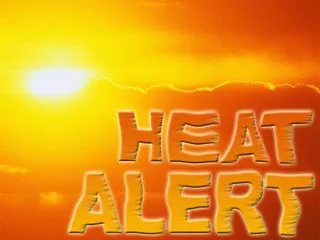Every summer, regions across the globe experience temperature spikes that can be not just uncomfortable, but dangerously life-threatening. An Excessive Heat Warning is more than just a hot day—it’s a government-issued alert that signals immediate risk to human health, particularly for vulnerable populations.
In this article, we’ll explore what an excessive heat warning means, what causes it, who’s most at risk, and—most importantly—how you can stay safe during extreme heat events.
What Is an Excessive Heat Warning?
An Excessive Heat Warning is an official notification issued by weather agencies like the National Weather Service (NWS) in the U.S. when heat conditions are expected to reach hazardous levels.
Criteria for Issuance
While criteria vary slightly by region, generally an excessive heat warning is triggered when:
- The heat index is forecast to reach 105°F (40.5°C) or higher for more than two consecutive days.
- Nighttime temperatures do not fall below 75°F (24°C), providing little relief.
- High humidity levels exacerbate the effect of heat.
Difference Between Heat Warning, Advisory, and Watch
| Term | Definition |
|---|---|
| Heat Advisory | Conditions are hot and potentially dangerous, but not life-threatening. |
| Heat Watch | Dangerous heat is possible in the near future—be alert and prepared. |
| Heat Warning | Dangerous and life-threatening heat is occurring or imminent. Act now. |
Why Excessive Heat Warnings Matter
Ignoring an excessive heat warning can be fatal. According to the CDC, extreme heat kills more people in the United States annually than hurricanes, floods, or tornadoes.
Health Risks Include:
- Heat Stroke
- Heat Exhaustion
- Dehydration
- Respiratory Distress
- Cardiovascular Complications
Who Is Most at Risk During an Excessive Heat Warning?
Extreme heat doesn’t affect everyone equally. Certain groups are particularly vulnerable, including:
- Elderly individuals (65+)
- Infants and young children
- People with chronic illnesses (diabetes, heart disease)
- Outdoor workers
- Athletes
- Low-income individuals without access to air conditioning
Heat-Related Illnesses Explained
1. Heat Exhaustion
Symptoms:
- Heavy sweating
- Weakness
- Cold, pale, clammy skin
- Fast, weak pulse
- Nausea or vomiting
Action:
Move to a cooler location, drink water, and use cool compresses.
2. Heat Stroke
Symptoms:
- Body temperature over 103°F (39.4°C)
- Red, hot, dry skin (no sweating)
- Rapid pulse
- Confusion or unconsciousness
Action:
This is a medical emergency. Call 911 immediately and begin cooling the person with water or ice.
Causes of Excessive Heat Events
Excessive heat warnings are typically caused by a combination of:
1. High Pressure Systems
These trap heat in a region, preventing cooler air from mixing and causing prolonged heat waves.
2. Urban Heat Island Effect
Cities absorb and retain heat due to asphalt, concrete, and lack of vegetation, making urban areas hotter than rural ones.
3. Climate Change
Global warming is increasing both the frequency and severity of heat waves worldwide.
4. Poor Infrastructure
Limited access to green spaces, shade, and air conditioning worsens heat impacts in many communities.
Historical Examples of Deadly Heat Waves
Chicago Heat Wave (1995)
- Over 700 deaths in one week
- Most victims were elderly and lived alone
European Heat Wave (2003)
- Claimed over 70,000 lives across Europe
- France was hit hardest, with hospitals overwhelmed
Pacific Northwest (2021)
- Temperatures exceeded 115°F in Portland, Oregon
- Hundreds died in a region not accustomed to extreme heat
Preparing for an Excessive Heat Warning
1. Monitor Local Weather
- Use weather apps, NOAA alerts, or local TV/radio stations
- Know when a heat advisory escalates to a warning
2. Plan Your Day Strategically
- Avoid outdoor activities from 10 AM to 4 PM
- Wear light-colored, breathable clothing
- Stay indoors during peak heat hours
3. Prepare Your Home
- Use blackout curtains to block sunlight
- Install fans or air conditioning
- Stock up on water and electrolyte drinks
4. Check On Vulnerable Neighbors
- Make calls or visits to elderly relatives and friends
- Help others without access to cooling or transportation
What To Do During an Excessive Heat Warning
Stay Cool
- Use air conditioning or visit a public cooling center
- Take cool showers or use wet towels on your body
- Avoid hot meals and caffeine
Stay Hydrated
- Drink water every 15–30 minutes
- Avoid sugary, alcoholic, or caffeinated drinks
- Eat fruits high in water content (watermelon, cucumbers)
Know Where to Go
- Libraries, malls, and community centers often open as cooling centers
- Contact local government for locations
Technology That Helps During Heat Warnings
1. Heat Index Calculators
Apps and websites help calculate “feels like” temperatures.
2. Smart Thermostats
These adjust your home temperature based on outside conditions.
3. Wearable Health Devices
Monitors track body temperature and hydration levels in real time.
Government and Community Response
Governments play a critical role in reducing the impact of excessive heat warnings. Programs often include:
- Opening Cooling Centers
- Emergency Text Alerts
- Suspending Evictions and Utility Shutoffs
- Urban Tree Planting Initiatives
How Excessive Heat Warning Impacts the Economy
1. Work Productivity Loss
Outdoor workers suffer the most. In sectors like agriculture and construction, productivity drops dramatically.
2. Health System Overload
ER visits spike during heat waves, especially for respiratory and cardiovascular issues.
3. Infrastructure Strain
Heat can buckle roads, warp railways, and cause power outages due to high air conditioner usage.
The Role of Climate Change in Intensifying Heat Warnings
The number of excessive heat warnings has skyrocketed in recent decades. Scientists agree that climate change is amplifying:
- Heatwave frequency
- Duration of extreme heat events
- Intensity (record-breaking temps)
Global Warming Projections
If current emission trends continue, experts predict:
- 3x more heatwaves in North America by 2050
- Massive heat-related migration in South Asia and Africa
Myths About Excessive Heat Debunked
| Myth | Reality |
|---|---|
| “I’m healthy, so heat doesn’t affect me.” | Even young, fit people are at risk if exposed too long. |
| “Fans are enough.” | Fans work in mild heat, but not when temps exceed body temperature. |
| “You only need water when you feel thirsty.” | Thirst is a late sign of dehydration—drink regularly. |
| “Only deserts get excessive heat.” | Cities, forests, and even coastal areas are experiencing deadly heat. |
Long-Term Solutions to Combat Extreme Heat
1. Urban Greening
Trees and green roofs reduce the urban heat island effect.
2. Reflective Infrastructure
Cool roofs and permeable pavements reflect sunlight and reduce heat absorption.
3. Climate Policy
Stronger carbon emission regulations can reduce future heat severity.
4. Early Warning Systems
More accurate forecasting allows for better preparation and response.
Real Stories: Surviving Excessive Heat Warnings
Ayesha, Phoenix, AZ:
“I lost power for 6 hours during a 116°F heatwave. It was terrifying. My elderly neighbor had no one to help her, so we invited her in. We survived together.”
David, Chicago:
“After my father passed in the 1995 heatwave, I’ve made it my mission to check on seniors every summer. Don’t underestimate the heat.”
Each year, scorching temperatures claim thousands of lives globally. While many think of heat as merely uncomfortable, an excessive heat warning is issued when weather conditions become not just oppressive but potentially lethal.
These warnings are public alerts to protect life, especially among vulnerable populations such as the elderly, children, and individuals with chronic health conditions. This article takes a comprehensive look at excessive heat warnings, including causes, impacts, safety tips, real stories, and what the future holds in a warming world.
Key Takeaways
- An Excessive Heat Warning is a life-threatening weather alert.
- Pay close attention to local alerts and take precautions early.
- Vulnerable populations must be prioritized for support and care.
- Hydration, shade, and community action can save lives.
- Climate change is a key driver of increasing extreme heat.
Act Now, Stay Cool, Stay Safe
Ignoring an Excessive Heat Warning could mean putting your life or others at risk. As the planet warms and extreme weather becomes more common, heat safety is not just an individual responsibility—it’s a public health imperative.
By staying informed, preparing in advance, and helping those around us, we can endure and adapt to the growing challenges posed by excessive heat.
Frequently Asked Questions (FAQ)
Q: What is the difference between an Excessive Heat Watch and Warning?
A: A watch means dangerous heat may happen. A warning means it is happening or will very soon.
Q: How can I find a cooling center near me?
A: Contact your city’s emergency management office or dial 211.
Q: Can pets be affected by excessive heat Warning?
A: Absolutely. Pets can suffer heat stroke—never leave them outside or in a hot car.
Q: How do I keep my home cool without AC?
A: Use blackout curtains, fans, cool showers, and keep lights and electronics off during the day.
What Is an Excessive Heat Warning?
An Excessive Heat Warning is an urgent alert from meteorological agencies like the National Weather Service (NWS) or equivalent organizations worldwide. It signals a high risk of heat-related illnesses or fatalities due to sustained, dangerously hot conditions.
Typical Criteria:
- Heat Index: 105°F (40.5°C) or higher for two or more days
- Low Nighttime Relief: Temperatures remain above 75°F (24°C)
- Humidity: High dew points that increase heat stress
- Urban Heat Amplification: Cities experience higher risk due to concrete surfaces and lack of shade
In countries like Pakistan, India, Australia, the U.S., and the Middle East, excessive heat warnings are increasingly common during the summer months, as climate patterns become more extreme.
The Science Behind Heat Index and Its Danger
The heat index, often referred to as the “feels like” temperature, is a combination of air temperature and humidity. High humidity hampers the body’s ability to cool itself through sweating, leading to a dangerous rise in internal temperature.
Why This Matters:
- A temperature of 95°F with 60% humidity feels like 113°F.
- When the heat index surpasses 130°F, heatstroke becomes imminent without intervention.
Vulnerable Populations: Who Faces the Highest Risk?
Though anyone can suffer from extreme heat, some individuals are significantly more vulnerable:
- Older adults (impaired thermoregulation)
- Babies and toddlers (underdeveloped sweat glands)
- Outdoor workers and athletes
- Low-income households (no AC or shade)
- People with heart, kidney, or lung conditions
- Pregnant women
Heat Disparities in Marginalized Communities
Studies show that Black and Hispanic neighborhoods in urban U.S. cities often face higher temperatures due to fewer trees and more concrete surfaces—a phenomenon known as environmental racism.
Case Study: Karachi Heat Wave (2015)
- Over 1,200 deaths in just a few days
- Hospitals overwhelmed; morgues reached capacity
- Many had no access to air conditioning
- Lack of preparedness and infrastructure worsened the crisis
This tragic event illustrates the urgent need for awareness, planning, and rapid response systems in countries vulnerable to extreme weather events.
Heat-Related Illnesses: Know the Symptoms
1. Heat Rash
- Itchy red bumps, usually in skin folds
- Common in infants and young children
2. Heat Cramps
- Muscle spasms due to salt loss
- Occur during or after intense activity
3. Heat Exhaustion
- Heavy sweating, weakness, dizziness, fainting
- Prompt action needed: hydration, rest, cooling
4. Heat Stroke (Life-Threatening)
- Body temp over 103°F (39.4°C)
- Skin may be hot and dry or moist
- Can cause seizures, unconsciousness, or death
How to Respond to an Excessive Heat Warning
Home Preparations
- Insulate windows with curtains or reflective film
- Seal leaks in doors/windows to retain cool air
- Set AC units to 78°F to prevent blackouts
Personal Care
- Hydrate even if not thirsty (every 15–30 minutes)
- Take cool showers or sponge baths
- Eat light meals (avoid spicy or hot foods)
Outdoor Safety
- Wear loose-fitting, light-colored clothes
- Use hats, umbrellas, and SPF 30+ sunscreen
- Rest frequently in shaded or air-conditioned areas
Digital Tools to Use
- Heat alerts via SMS or weather apps (e.g., AccuWeather, NWS, NDMA)
- Smart home systems for AC management
- GPS alerts to find cooling shelters
Community Action During Heat Warnings
Communities play a vital role in preventing heat-related deaths:
- Check on elderly neighbors
- Provide free transportation to cooling centers
- Organize water distribution drives
- Set up emergency shelters with fans and generators
Case in Point: France (2022)
After the deadly 2003 heat wave, France revamped its entire public health response:
- “Canicule Plan” includes automated senior check-ins
- Air-conditioned metro cars and public cooling spaces
- Awareness campaigns through all media platforms
Environmental and Urban Impacts of Extreme Heat
1. Infrastructure Breakdown
- Roads buckle from expansion
- Power lines sag and fail
- Water systems dry up or overheat
2. Transportation Disruption
- Train tracks can warp
- Airlines must reduce flights due to air density
- Traffic accidents increase due to driver fatigue
3. Air Quality Deterioration
- Ozone levels rise
- Increased asthma attacks and lung irritation
- Wildfires during heat waves further pollute the air
Economic Costs of Excessive Heat
According to the World Bank, heatwaves cost the global economy $2.3 trillion annually through lost productivity, damaged infrastructure, and healthcare costs.
| Sector | Impact |
|---|---|
| Agriculture | Crop failures, livestock deaths, irrigation failure |
| Retail | Fewer customers in stores, higher cooling costs |
| Construction | Delays due to unsafe working conditions |
| Tourism | Event cancellations, reduced outdoor activity bookings |
Global Stats on Heat Wave Fatalities
- India (2023): 41,000+ heat-related deaths over a decade
- Europe (2022): 61,000+ excess deaths linked to heat
- U.S. (2021): 1,577 confirmed heat-related deaths
- Middle East: Temperatures reach over 54°C (129°F) in places like Kuwait and Basra
These numbers are projected to double or triple by 2050 if current trends persist.
Heat Preparedness Around the World
| Country | Strategy |
|---|---|
| Australia | National Heatwave Forecast and early warning system |
| Japan | Cooling shelters, public misting systems, “cool biz” attire |
| Pakistan | NDMA heat alerts, tree plantation in cities like Lahore |
| Canada | Heat Alert and Response System (HARS) |
Climate Change: The Root Cause of Escalating Heat Events
According to IPCC reports:
- Global temperatures have risen by 1.2°C since pre-industrial times.
- 2023 was the hottest year on record globally.
- Future scenarios predict extreme heat days (above 95°F) could increase 5x by 2100.
Feedback Loops Make It Worse
- Droughts dry out land, which in turn heats up faster.
- Fewer trees mean more exposed surfaces absorb and radiate heat.
- Melting ice caps reduce the Earth’s reflectivity (albedo), absorbing more solar energy.
Mitigating the Future: What Can Be Done?
1. Plant More Trees
- Trees can lower local temperatures by 5–10°F
- Urban forestry reduces energy use and improves air quality
2. Implement Cool Roofs
- Reflective or white-painted roofs reduce indoor temps
- Already mandated in cities like Los Angeles and New York
3. Green Infrastructure
- Parks, wetlands, and green corridors reduce urban heat
- Water features help cool surrounding areas
4. Climate Resilience in City Planning
- Require heat-proof buildings in zoning codes
- Fund research on heat-adaptive crops
- Build underground transit stations and emergency shelters
Real-Life Survivor Stories: Heatwave Resilience
Maria, Spain (2022):
“The fan was useless. I soaked towels in cold water and wrapped them around my kids. The electricity bill doubled, but we survived.”
Tariq, Multan (2023):
“We dug a trench and filled it with water as a cooling pit for livestock. No one helps us here, so we innovate.”
Lina, New York (2021):
“A citywide blackout hit during the heatwave. Elevators stopped, seniors were stuck, and no one had water. It was chaos.”
These accounts highlight the human toll—and the resilience—that define the climate crisis.
International Call to Action
Governments, industries, and individuals must work in tandem to reduce heat-related harm.
Policy Priorities:
- Invest in climate-resilient infrastructure
- Mandate heat risk assessments in urban planning
- Create mandatory break laws for outdoor workers
- Make heatwave days public health holidays where necessary
Conclusion: Responding to the New Normal
An excessive heat warning is no longer rare—it’s becoming the new seasonal norm. These alerts must be treated with the same urgency as hurricanes or earthquakes.
Heat doesn’t just cause discomfort—it causes deaths, economic disruptions, and societal strain. With proactive planning, education, and community cooperation, we can navigate this era of extreme heat more safely.
Staying cool is no longer a luxury—it’s survival.
Final Checklist: Excessive Heat Survival Kit
✅ Reusable water bottles
✅ Battery-powered fan
✅ Electrolyte powder or ORS
✅ Lightweight clothing
✅ List of nearby cooling centers
✅ Backup battery or power bank
✅ Thermometer and first aid kit
✅ Flashlight (for power outages) https://whatsapp.com/channel/0029Vb6hgkVFSAsxj1pX1G1v



